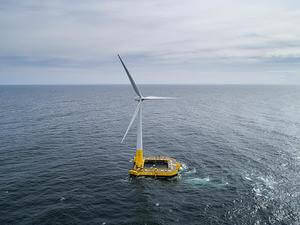News Release from windfair.net
Wind Industry Profile of
FloaWER: International Research Project to Bring Floating Wind Turbines to Market Maturity
Frank Adam from the Academic Chair of Wind Energy Technology (LWET) at the University of Rostock, Germany, has acquired this new EU project together with research institute École Centrale Nantes (ECN) in France, which also manages the project. In the coming years, scientists from various European nations and research institutions will work together on it.
A total of 134 countries were eligible to apply. The aim of the EU programme is to support the best young scientists. "As an academic chair, we are one of ten scientific institutions in this European research project in which doctoral students are trained in a structured manner with a total volume of 3.5 million euros," says Adam.
It's not the first project in Rostock to deal with floating wind turbines. Research has already been carried out here in collaboration with the GICON group on the development and scale testing of a substructure for third-generation wind turbines for turbines from 6 MW.
 The project partners can also look back on many years of experience in the field of floating turbines. For example, the Floatgen turbine (picture left, copyright: Ideol), which has been in operation off the French coast since last year and has already provided valuable research input, was co-developed at the ECN in Nantes.
The project partners can also look back on many years of experience in the field of floating turbines. For example, the Floatgen turbine (picture left, copyright: Ideol), which has been in operation off the French coast since last year and has already provided valuable research input, was co-developed at the ECN in Nantes.
Floating turbines offer many advantages over conventional offshore turbines. "Wind turbines can operate in deep waters," explains Adam. This means that many new regions could benefit from offshore wind in the future. In addition to European coasts such as the Mediterranean and Atlantic coasts, the industry is also focusing on the waters around Japan and the US west coast.
A further advantage of the floating facilities is that they no longer require expensive installation ships. Floating wind turbines can already be mounted on the foundation structure in the harbour basin and then be towed to the intended location by tugs, where they're simply anchored. This also eliminates the pile-driving work, a frequent subject of criticism as the noise it produces can affect sea dwellers such as harbour porpoises.

The project includes a variety of research approaches (Image: FloaWER)
All ten partners in the research project are dealing with different issues relating to the floating turbines. This involves various technical details or cost minimisation. The Rostock researchers are focusing on structural optimization, i.e. on ensuring that the system has a service life of up to 25 years and is sustainable and cost-effective. For this purpose, simulation software is used to calculate how the floating wind turbines behave in wind and weather, also with regard to the use of novel materials.
- Author:
- Katrin Radtke
- Email:
- press@windfair.net
- Keywords:
- University, Rostock, international, research, floating, wind turbine, floater, ECN, EU, structure, Floatgen, GICON, Ideol

























